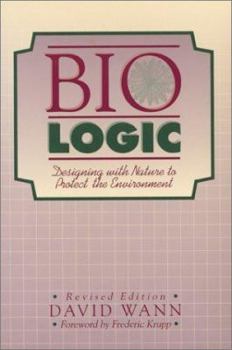Biologic: Designing With Nature to Protect the Environment
Select Format
Select Condition 
Book Overview
Since "Biologic" first appeared, it has received widespread praise from architects, planners, and environmental consultants, as well as concerned citizens for its balanced, well-reasoned approach to... This description may be from another edition of this product.
Format:Paperback
Language:English
ISBN:155566122X
ISBN13:9781555661229
Release Date:January 1994
Publisher:Johnson Books
Length:288 Pages
Weight:1.07 lbs.
Dimensions:9.0" x 1.0" x 6.0"
Customer Reviews
2 ratings
A balanced, well-reasoned approach to environmental education
Published by Thriftbooks.com User , 19 years ago
My first lessons on the environmental consequences of our individual & community actions came from reading R Buckiminster Fuller's Critical Path & attending one of his workshops in USA in the early 90s. Bucky, as he was often known, was acknowledged as Planet Earth's Friendliest Genius. I was quite intrigued by his work & creations. Among the first few books on environmental education, I somehow got hold of Biologic, the contents of which have been most fascinating for me. Although somewhat technical, I found the writing of the book to be quite light-hearted in some way. The book is structured in five thematic chapters as follows: Chapter 1: Biologic Chapter 2: Knowing - environmental awareness; Chapter 3: Choosing - individual action; Chapter 4: Designing - societal & technical experimentation; Chapter 5: Implementing In a nutshell, this book is about a new way of thinking. To use the author's own words: "Using biologic, we must rethink everything from energy use to the way we advertise our products. As the paradigm of our culture, we must replace the unwavering arrow of "forward progress' [an illusion] with the continous loop of recycling (the way nature actually works). To do this, we must make use of every available tool - from free market mechanisms to government intervention. Only by making an unstinting effort at every level of society can we make the change that will allow us to prosper & not just survive." The author introduces ten Biologic principles, which I would like to recap as follows: 1. Understanding basic physical concepts like gravity, nutrient cycles, & the flow of sun, wind & water - so decisions can be based on what's really here rather than what can be done with the "mirrors" of once-only energy; 2. Using resources on a sustainable basis, taking only the "interest" out of our ecological savings account rather than dipping into the principal; 3. Using the right tool for the right job. We need a diverse toolkit of solutions, & in many cases we'll have to use more than a single tool; 4. Carefully monitoring & streamlining what goes in so that junk will not come out along with the intended product; 5. Developing the habit of tracing the origins & future route of each physical interaction so that something enjoyed in the present doesn't leave a hole in the future, & nothing discharged or thrown away here become a compound problem there; 6. Acknowledging the uniqueness of each location & its suitability for certain uses only; 7. Using the simplest process or product to get the job done so the environment benefits as well as the manufacturer; 8. Using software (information) rather than hardware whenever possible to reduce inevitable collisions between imprecise human design & "custom-fit" natural design; 9. Using design solutions that accomplish three or four things at once; 10. Accounting for costs with the full lifetime of the product in mind; I must admit some ideas in the book are not new, b
To Protect the Environment, First Understand Nature
Published by Thriftbooks.com User , 24 years ago
When I wrote Biologic in the early 90s, it was after I had an epiphany about Human/Nature. We are altering the planet's biosphere radically because we don't design to meet the needs of nature and humans. I did extensive research on the way nature works, which was built upon my own years of hands-on experience in the garden.I wrote a book that explains new ways of thinking: preventively, holistically, bio-logically, then designing our products, our agriculture, transportation, architecture, and so on WITH NATURE IN MIND.The book has been an inspiration to creative thinkers like Amory Lovins, Paul Hawken, Hazel Henderson, and many others, and is just as relevant in its accessible, non-academic, core thinking as it was when I wrote it.College professors have told me their students will read this concept book far more readily than a typical textbook, and that Biologic tends to generate lots of creative discussion.Have a look-- whether you're a businessperson,an educator, a consumer, or a designer, you'll find food for thought here. As Edward Abbey phrased it, "We must learn to think not only logically, but biologically..."






